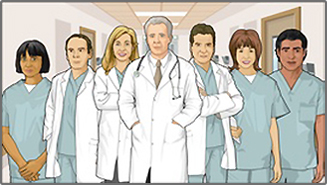Polymyositis - adult
Polymyositis and dermatomyositis are rare inflammatory diseases. These diseases lead to muscle weakness, swelling, tenderness, and tissue damage. They are part of a larger group of diseases called myopathies, more specifically inflammatory myopathies.
Causes
Polymyositis affects the skeletal muscles. It is also known as idiopathic inflammatory myopathy. The exact cause is unknown, but it may be related to an autoimmune reaction or infection.
Polymyositis can affect people at any age. It is most common in adults between ages 50 and 60, and in older children. It affects women twice as often as men. It is more common in African Americans than white people.
Symptoms
Polymyositis is a systemic disease. This means it affects the whole body. Muscle weakness and tenderness can be signs of polymyositis. A rash is a sign of a related condition, dermatomyositis.
Dermatomyositis
Dermatomyositis is a disease that involves muscle inflammation and a skin rash. Polymyositis is a similar inflammatory condition that also involves ...

Common symptoms include:
- Muscle weakness in the shoulders and hips. This can make it hard to raise the arms over the head, get up from a sitting position, or climb stairs.
- Difficulty swallowing.
Difficulty swallowing
Difficulty with swallowing is the feeling that food or liquid is stuck in the throat or at any point before the food enters the stomach. This proble...
 ImageRead Article Now Book Mark Article
ImageRead Article Now Book Mark Article - Muscle pain.
- Problems with the voice (caused by weak throat muscles).
- Shortness of breath.
Shortness of breath
Breathing difficulty may involve:Difficult breathing Uncomfortable breathingFeeling like you are not getting enough air
 ImageRead Article Now Book Mark Article
ImageRead Article Now Book Mark Article
You may also have:
- Fatigue
Fatigue
Fatigue is a feeling of weariness, tiredness, or lack of energy.
 ImageRead Article Now Book Mark Article
ImageRead Article Now Book Mark Article - Fever
- Joint pain
- Loss of appetite
- Morning stiffness
- Weight loss
- Skin rash on the back of the fingers, on the eyelids, or on the face
Exams and Tests
Tests may include:
- Autoimmune antibodies and inflammation tests
- Serum CPK (creatine phosphokinase)
- Serum aldolase
- Electromyography
Electromyography
Electromyography (EMG) is a test that checks the health of the muscles and the nerves that control the muscles.
 ImageRead Article Now Book Mark Article
ImageRead Article Now Book Mark Article - MRI of affected muscles
- Muscle biopsy
- Myoglobin in the urine
- Electrocardiogram (ECG)
Electrocardiogram
An electrocardiogram (ECG) is a test that records the electrical activity of the heart.
 ImageRead Article Now Book Mark Article
ImageRead Article Now Book Mark Article - Chest x-ray and CT scan of the chest
- Pulmonary function tests
- Esophageal swallowing study
- Myositis specific and associated autoantibodies
People with this condition also must be watched carefully for signs of cancer.
Treatment
The initial treatment is the use of corticosteroid medicines. The dose of medicine is slowly tapered off as muscle strength improves. Medicines to suppress the immune system may be used to replace the corticosteroids. These medicines may include azathioprine, methotrexate, rituximab (Rituxan), or mycophenolate.
For disease that remains active in spite of corticosteroids, intravenous gamma globulin can be given. It is important to check for other conditions in people who do not respond to treatment. A repeat muscle biopsy may be needed to make this diagnosis.
If the condition is associated with a tumor, it may improve if the tumor is removed.
Outlook (Prognosis)
Response to treatment varies, based on the complications. As many as 1 in 5 people may die within 5 years of developing the condition.
Many people, especially children, recover from the illness and do not need ongoing treatment. For most adults, however, immunosuppressant medicines are needed to control the disease.
The outlook for people with lung disease with the anti-MDA-5 antibody is poor despite current treatment.
In adults, death may result from:
- Malnutrition
- Pneumonia
Pneumonia
Pneumonia is inflamed or swollen lung tissue due to infection with a germ. This article covers community-acquired pneumonia (CAP). This type of pneu...
 ImageRead Article Now Book Mark Article
ImageRead Article Now Book Mark Article - Respiratory failure
- Severe, long-term muscle weakness
The major causes of death are cancer and lung disease.
Possible Complications
Complications may include:
- Calcium deposits in the affected muscles, especially in children with the disease
- Cancer
- Heart disease, lung disease, or abdominal complications
Lung disease
Lung disease is any problem in the lungs that prevents the lungs from working properly. There are three main types of lung disease:Airway diseases -...
 ImageRead Article Now Book Mark Article
ImageRead Article Now Book Mark Article
When to Contact a Medical Professional
Contact your health care provider if you have symptoms of this disorder. Seek emergency treatment if you have shortness of breath and difficulty swallowing.
Reviewed By
Diane M. Horowitz, MD, Rheumatology and Internal Medicine, Northwell Health, Great Neck, NY. Review provided by VeriMed Healthcare Network. Also reviewed by David C. Dugdale, MD, Medical Director, Brenda Conaway, Editorial Director, and the A.D.A.M. Editorial team.
Greenberg SA. Inflammatory myopathies. In: Goldman L, Cooney KA, eds. Goldman-Cecil Medicine. 27th ed. Philadelphia, PA: Elsevier; 2024:chap 248.
Nagaraju K, Aggarwal R, Lundberg IE. Inflammatory diseases of muscle and other myopathies In: Firestein GS, Mclnnes IB, Koretzky GA, Mikuls TR, Neogi T, O'Dell JR, eds. Firestein & Kelley's Textbook of Rheumatology. 12th ed. Philadelphia, PA: Elsevier; 2025:chap 86.
National Organization for Rare Disorders website. Polymyositis and necrotizing myopathy. rarediseases.org/rare-diseases/polymyositis/. Updated August 26, 2019. Accessed March 24, 2025.




